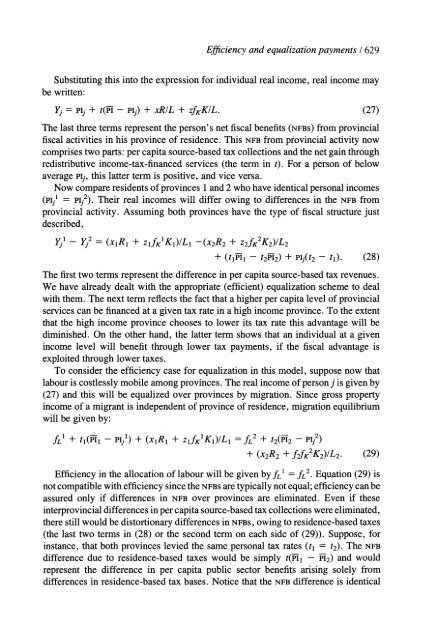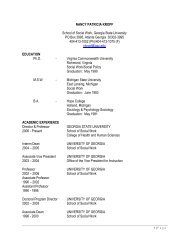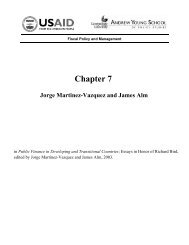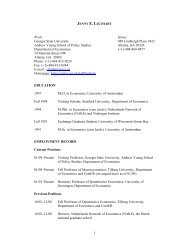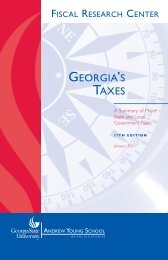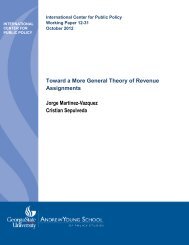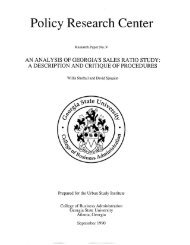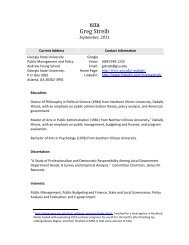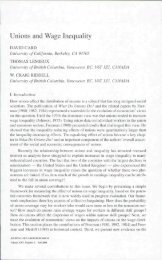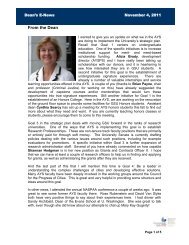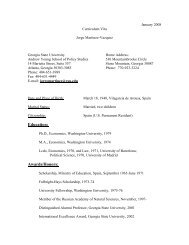Robin Boadway and Frank Flatters - Andrew Young School of Policy ...
Robin Boadway and Frank Flatters - Andrew Young School of Policy ...
Robin Boadway and Frank Flatters - Andrew Young School of Policy ...
Create successful ePaper yourself
Turn your PDF publications into a flip-book with our unique Google optimized e-Paper software.
Efficiency <strong>and</strong> equalization payments / 629<br />
Substituting this into the expression for individual real income, real income may<br />
be written:<br />
Yj = PIj + t(Pi - PIj) + xRIL + zfKK/L. (27)<br />
The last three terms represent the person's net fiscal benefits (NFBS) from provincial<br />
fiscal activities in his province <strong>of</strong> residence. This NFB from provincial activity now<br />
comprises two parts: per capita source-based tax collections <strong>and</strong> the net gain through<br />
redistributive income-tax-financed services (the term in t). For a person <strong>of</strong> below<br />
average Pij, this latter term is positive, <strong>and</strong> vice versa.<br />
Now compare residents <strong>of</strong> provinces 1 <strong>and</strong> 2 who have identical personal incomes<br />
(PIj1 = PIl2). Their real incomes will differ owing to differences in the NFB from<br />
provincial activity. Assuming both provinces have the type <strong>of</strong> fiscal structure just<br />
described,<br />
Yj -j2<br />
=<br />
(xlR1 + ZlfK1Kl)/L -(X2R2 + Z2fK2K2)/L2<br />
+ (tiiil<br />
-<br />
t2PI2) + Pij(t2 - tl). (28)<br />
The first two terms represent the difference in per capita source-based tax revenues.<br />
We have already dealt with the appropriate (efficient) equalization scheme to deal<br />
with them. The next term reflects the fact that a higher per capita level <strong>of</strong> provincial<br />
services can be financed at a given tax rate in a high income province. To the extent<br />
that the high income province chooses to lower its tax rate this advantage will be<br />
diminished. On the other h<strong>and</strong>, the latter term shows that an individual at a given<br />
income level will benefit through lower tax payments, if the fiscal advantage is<br />
exploited through lower taxes.<br />
To consider the efficiency case for equalization in this model, suppose now that<br />
labour is costlessly mobile among provinces. The real income <strong>of</strong> person j is given by<br />
(27) <strong>and</strong> this will be equalized over provinces by migration. Since gross property<br />
income <strong>of</strong> a migrant is independent <strong>of</strong> province <strong>of</strong> residence, migration equilibrium<br />
will be given by:<br />
fL1 + tl(PIl - PI1) + (X1R1 + ZIfK1Kl)/Ll =fL2 + t2(i2 - PI2)<br />
+ (x2R2 + f2fK2K2)/L2.<br />
Efficiency in the allocation <strong>of</strong> labour will be given by fL = fL2. Equation (29) is<br />
not compatible with efficiency since the NFBS are typically not equal; efficiency can be<br />
assured only if differences in NFB over provinces are eliminated. Even if these<br />
interprovincial differences in per capita source-based tax collections were eliminated,<br />
there still would be distortionary differences in NFBS, owing to residence-based taxes<br />
(the last two terms in (28) or the second term on each side <strong>of</strong> (29)). Suppose, for<br />
instance, that both provinces levied the same personal tax rates (tl = t2). The NFB<br />
difference due to residence-based taxes would be simply t(Pii - PI2) <strong>and</strong> would<br />
represent the difference in per capita public sector benefits arising solely from<br />
differences in residence-based tax bases. Notice that the NFB difference is identical<br />
(29)


